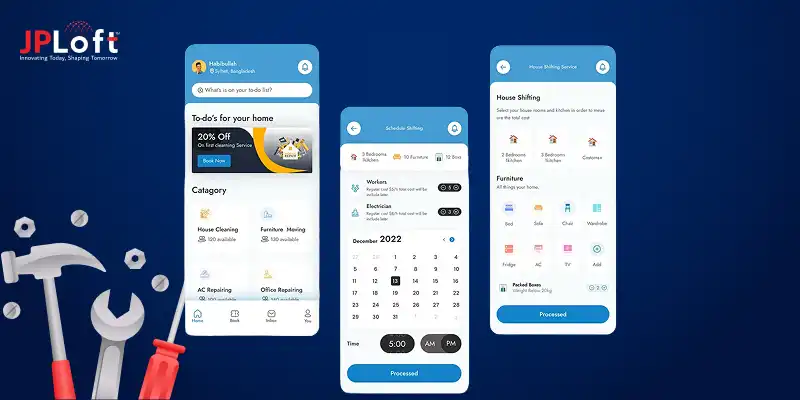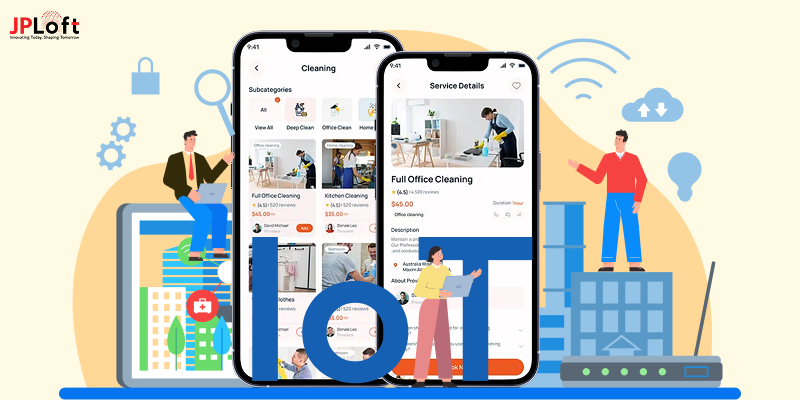Key Takeaways:
Follow Apple’s guidelines from day one to cut rejections and speed time to market. A compliance-first build moves faster through App Store review.
Core practices like UI/UX alignment, privacy compliance, and real-world testing ensure you launch a handyman app on the App Store successfully.
Be transparent about data. Clear privacy policy, ATT prompts, and secure payments earn reviewer trust and reduce delays for handyman apps.
Respect payment and location rules. Use approved in-app purchases for digital goods and justify location access to avoid policy violations.
Work a checklist. Prepare certificates, upload via Xcode, complete App Store Connect details, and then publish the app on the App Store confidently.
Partnering with JPLoft, a trusted app development company, helps you build compliant apps that pass Apple’s review and gain user trust.
"Quality is never an accident; it is always the result of intelligent effort." – John Ruskin
When it comes to building and launching apps, this quote perfectly fits Apple’s strict review process. The big question many founders ask is: How to get your Handyman App approved on the App Store?
The answer lies in meeting Apple’s technical, design, and compliance standards while ensuring your app provides real value to users.
This blog is crafted for entrepreneurs, startups, app developers, and investors who want to transform handyman services into successful digital platforms.
By understanding Apple’s review system, you’ll know exactly how to prepare your app, avoid common rejection mistakes, and ensure a smooth approval process.
From testing stability and safeguarding user data to crafting accurate metadata, every step counts. With the right approach, you won’t just pass Apple’s checks; instead, you’ll launch a handyman app that users trust and download confidently.
Let’s begin the journey together.
Understanding Apple’s App Store Review
Let’s learn about Apple’s review procedure and what it contains below:
In the current world, apps are changing the world, enriching people’s lives, and enabling developers to innovate like never before.
As a result, the app store has grown into an exciting ecosystem for the millions of developers and even for more than a billion users.
Additionally, whether you are a first-time developer or an experienced one, or even a person launching your app on the iOS store, learning about the review systems can help you launch a fully functional, accurate, and bug-free app with clear explanations.
Apple’s app store review is an important procedure for reviewing the apps. Along with this, it is important to understand Apple’s strict review process.
Every app undergoes a detailed evaluation to ensure that it meets Apple’s technical, content, and design guidelines.
Here, the review team can check for performance issues, security compliance, data privacy practices, and whether the app delivers real value to the users.
Additionally, for handyman apps, features such as location tracking, payment integration, and user data handling are closely interconnected.
Even the small issues, such as misleading descriptions, poor UI/UX, or crashes, can lead to the rejection of your app.
In short, Apple’s review procedure is all about the evaluation process that every step should go through before being published. Here, Apple checks for security, performance, design quality, and policy compliance to ensure that the apps provide a safe and reliable user experience.
Apple’s App Store Review is the evaluation process every app goes through before being published. Apple checks for security, performance, design quality, and policy compliance to ensure apps provide a safe and reliable user experience.
Now, let’s learn about the pre-submission preparation to launch the handyman app in the following section.
Pre-Submission Preparation to Launch Handyman App
When you publish your app on the app store, one of the crucial segments to note here is whether your app is complete in its functionality, has been tested thoroughly, and more.
Hence, let’s discuss the following steps before you submit your app to the iOS App Store or before the handyman app approval on the iOS App Store
1. Ensure Completeness and Functionality
Is the handyman app development process completed? Or you require additional time for the same. This is all you have to evaluate completely when it comes to a handyman app.
Additionally, you should evaluate the complete functions of your app. Here, you have to assess the user-friendliness, ability to browse/book services, communication tools, real-time tracking of service providers, and secure payment integration, along with a robust review system.
2. Test Thoroughly and Optimize Performance
When it comes to the handyman app, it's significant to test your app thoroughly and optimize the complete performance of the users.
Additionally, here you should undergo rigorous testing across different iPhone and iPad models to confirm consistent performance. Get your handyman app approved on the Apple App Store by identifying the user’s needs and the present market competition.
Along with this, you should conduct real-world testing for booking flows, payments, push notifications, and location-based features since these are the important elements in the handyman apps.
Here, you can use tools such as TestFlight to gather beta feedback, identify bugs, and even resolve glitches.
3. Maintain Data Privacy and Security
It's important to maintain data privacy and mobile app security before you launch it in this competitive environment. User privacy is significant to Apple, and in the case of handyman apps, where personal data such as addresses, contact data, and other crucial information is essential.
Other than this, if you are using the background location services or push notifications, it's significant to mention the data privacy in advance. Here, you should comply with Apple’s App Tracking Transparency (ATT) policies, giving users control that helps to establish trust.
4. UI/UX Alignment before Handyman App Placement
The iOS platforms appreciate apps that adhere to their human interface guidelines. Additionally, the handyman app needs to have simple navigation, visually uniform layouts, and interactive elements that look iOS-native.
Along with this, the simple onboarding, seamless booking experiences, and clear service listings make the app more attractive to the users and even to the review team. If the mobile app design doesn’t fulfill Apple’s expectations, then the rejection is highly probable.
5. Proper Metadata
Metadata for the app is the initial impression that you create with Apple and prospective users. Here, you need to know that for getting your handyman app approved, it's important that the app name is small.
You should describe the main handyman services, special features, and advantages of your app. Here, you need to see good-quality screenshots that demonstrate the booking process, service details, and payment procedure. Additionally, the brief preview clip can lend credibility to your app. The inaccurate or incomplete metadata commonly results in rejection.
6. Check for Legal and Policy Compliance
One of the important elements to evaluate is to check for legal and policy compliance. Here, it's significant to note that Apple’s review procedure does inspect apps for adherence to its own rules as well as application legislation. A handyman app typically has payments, location services, and user-generated content, all of which have certain limitations.
It's significant to ensure that the app employs Apple’s recommended in-app purchase mechanisms, is in accordance with the use of location data rules, and maintains explicit user agreements. Hence, transparency and compliance not only accelerate the approval procedure but also safeguard your app from any future legal problems.
Now, the question is “ what are the technical requirements to meet while approving a handyman app?” Hence, let’s proceed with the following section.
What are the Technical Requirements to Meet While Approving a Handyman App?
To release your app on the iOS store, Apple demands strict technical adherence. Such requirements are meant to ensure your handyman app is stable, secure, and offers a top-notch experience to users.
You should evaluate the handyman app tech stack thoroughly, identify the challenges, and overcome them with effective measures.
Developers have to test performance on various iOS devices, avoid crashes, and maintain the app to work smoothly in real-life circumstances.
Apple also verifies compatibility with its current iOS versions, examines API use, and verifies features such as location tracking, payments, and notifications against guidelines. Compliance with these technical standards raises your prospects of rapid approval.
Let’s discuss the complete technical requirements below:
|
Requirement |
Description |
|
iOS Compatibility |
The app must support the latest iOS version and run smoothly on different devices. |
|
Performance & Stability |
No crashes, lag, or unresponsive features during use. |
|
API Usage |
Only use Apple-approved APIs; avoid private or restricted ones. |
|
App Size Optimization |
Keep the app lightweight to ensure fast downloads and updates. |
|
Security Compliance |
Secure data handling, encrypted APIs, and SSL/TLS for payments. |
|
Battery & Resource Usage |
Efficient coding to avoid draining the battery or overusing memory. |
|
Location Services |
Proper permission requests and justified use for handyman job bookings. |
|
Push Notifications |
Must be relevant, non-spammy, and comply with Apple’s notification rules. |
After evaluating the technical requirements for the handyman apps, let’s learn about the procedure of submitting a handyman app on iOS in the following section.
How to Submit or Publish a Handyman App on iOS App?
Now, when you start the online handyman business, it's essential to look at how you want to submit or publish a handyman app on iOS.
Hence, let’s consider the following steps to pass your handyman app on the Apple App Store.
Step 1: Join the Apple Developer Program
You need to be a member of the Apple Developer Program, which costs $99/year, before you can publish it.
This program provides you access to all the tools, such as Xcode, TestFlight, App Store Connect, and beta testing tools, required to distribute your app publicly.
Here, you should note that without the membership, you cannot publish the app publicly. Here, you should ensure signing up as an individual or organization, as per your business requirements.
Step 2: Get Your App Build Ready in Xcode
Now, under this step, you should open the handyman app project in Xcode and set up crucial identifiers such as Bundle ID and version number. Here, you need to set up provisioning profiles and digital certificates so your app can be signed properly.
Here, you should note that Apple will not accept the unsigned apps; hence, you should perform this step carefully. It's important to ensure that your app is built with the latest iOS version and is optimized for iPhones as well as iPads.
Step 3: Test the App Rigorously with TestFlight
Prior to submission, use TestFlight to share your app with testers. This enables you to collect real-world feedback from a maximum of 10,000 testers.
Get them to test booking services, payments, and useful handyman features such as location tracking. Get feedback, address problems, and refine your app. Apps with bugs and crashes stand an extremely high chance of being rejected in Apple's review.
Step 4: Set Up App Store Connect Account
App Store Connect is where all your app details are managed. Log in with your Apple Developer account and create a new app record. This is all about setting up the store connect when it comes to the handyman app.
Here you’ll fill in the app’s name, primary language, bundle ID, SKU (unique identifier), and platform (iOS). This step essentially creates your app’s placeholder on the App Store.
Step 5: Add App Metadata & Store Listing Information
In this step, you should add to the Metadata what appears first to users and Apple, so it must be correct and attractive. Provide a concise and compelling description that captures the handyman app's main aspects, including service booking, instant scheduling, and secure payments.
Upload your app icon in the proper size, screenshots that demonstrate the workflow, and an optional preview video. Remember to include appropriate keywords for App Store optimization. Misleading metadata is among the leading causes of app rejection.
Step 6: Implement the App Policies & Compliance Setup
All apps are required to have a valid privacy policy URL. As handyman apps handle sensitive user information such as addresses, phone numbers, and payments, you must prove secure handling of data. It's important to look for the handyman app security compliance for improving the app’s guarantee to launch on the iOS store.
If your app gathers location information, Apple demands a justification in the submission. In addition, turn on App Tracking Transparency (ATT) if you incorporate third-party analytics or ads. This transparency instills trust in users and is consistent with Apple's privacy-first philosophy
Step 7: Set Pricing & Availability
Within App Store Connect, determine whether your handyman app will be free or paid. If you intend to provide in-app purchases (e.g., upgraded handyman services), set them up here. Under the process of submitting the handyman app on the App Store, there is an important note.
Then, choose where you'd like your app to be available. For handyman apps that are geography-specific, set it to those areas only, but if more global exposure is desired, use global availability.
Step 8: Upload App Build through Xcode
Now, when you proceed to publish your handyman app on the app store, it's significant to upload the app build through Xcode. After all the preparations, return to Xcode, archive your build, and upload it directly to App Store Connect.
Apple's system will perform an initial validation to identify technical problems such as unsupported APIs, huge file sizes, or missing configurations. If errors are encountered, correct them before resubmission. A clean, correctly signed build maximizes your chances of approval.
Step 9: Submit for Review
Once your build is submitted, associate it with your app record on App Store Connect. Verify that every field is filled in, including screenshots, privacy information, metadata, and compliance.
Then, submit the app for review by Apple. Review time varies but typically takes 24–48 hours. But intricate apps or those that need to be checked more thoroughly (such as handyman apps with payment systems) might take longer.
Step 10: Get Approval & Publish
Once Apple’s review team approves your app, you’ll get an email notification. At this point, your handyman app will be live on the App Store for users to download. Monitor performance closely in the first few weeks, as early user reviews and crash reports can influence your ranking.
Be prepared to roll out timely updates to fix any issues and maintain compliance with Apple’s evolving guidelines. Here, you need to proceed with the handyman app maintenance process that will be crucial for optimizing the overall performance of your app.
Now, as you know, to get your handyman app approved on the App Store, some possibilities can result in app rejection while submitting it on the iOS store.
Let’s learn them all in the following section.
Reason for Getting Your Handyman App Rejected on App Store
Lack of mobile app testing is a significant reason why your app can get rejected from the store.
Furthermore, you can consider the significant reasons in the following section.
1. Bugs and Performance Issues
Apple will reject apps that crash, freeze, or perform slowly while being tested immediately. If your handyman app is not stable, it will not be approved.
Testing extensively across devices is necessary before considering how to publish a handyman app on the iOS store in order to demonstrate that your app provides a smooth and consistent experience.
2. Non-Compliance with Guidelines
Apple's App Store Review Guidelines are rigorous. Handyman apps that don't comply with policies related to payments, content, or data management become suspicious.
For instance, adopting an unapproved payment system in place of Apple's in-app purchasing guidelines can lead to rejection. Being well-versed in these rules ensures you can cruise through app store compliance.
3. Incomplete or Misleading Metadata
Metadata involves the name of your app, description, screenshots, and keywords. If they do not come with the actual functionality of the app, Apple considers it deceptive.
Most handyman apps get rejected because they feature functions in images that do not exist. Accurate and truthful metadata is important to establish trust and overcome App Store checks. Clear, truthful, and complete metadata builds trust and helps you get through App Store checks smoothly.
4. Privacy and Data Handling Issues
Handyman apps collect sensitive data like addresses, contact numbers, and payment details. If your app lacks a transparent privacy policy or doesn’t properly secure user data, Apple won’t approve it.
Compliance with Apple’s privacy framework ensures your app meets the growing concerns around data protection while proving you’re ready to publish on App Store responsibly.
5. Insufficient Functionality or Poor UX
Apple turns down applications that resemble "minimal templates" or do not provide actual value. A handyman application in the form of a simple booking form without smart navigation or service pages might not pass the cut.
In order to successfully distribute your app in the iOS store, you must demonstrate obvious utility, a neat design, and functionality geared towards meeting the needs of users.
Following the handyman app testing can be a relevant factor here, to enhance the overall performance of your app, and reduce the risks of getting rejected over the app store.
Now, let’s move ahead with the measures to take if your handyman app gets rejected from the app store in the next section.
What to do If Your App Gets Rejected?
It's important to look for the reason for rejection and mitigate the issues as soon as you can if your handyman app gets rejected over the app store.
Yes, you might face challenges while creating a handyman app, but if you face issues in submitting your app to the app store, this can result in rejection.
Now, let’s move ahead with the measures to take for addressing rejection cases while launching the app on the app store in this section.
1] Clearly Understand the Rejection Cause
Apple always sends a rejection note stating why your app failed. Go through it carefully and determine if it's a technical, design, or compliance-related problem. Without fixing this root cause, attempting to submit an app to the iOS store again will result in repeated rejection.
Other than this, if you fail to understand the cause of rejection, this can impact the timeline to launch your app on the OS store, and will further result in maximum attempts of failure.
2] Correct Bugs and Compliance Flaws
If the reason for rejection was due to crashes, bad UI, or abuse of APIs, focus on correcting those issues.
In the case of handyman apps, typical gaps are improper payment processing or ambiguous location permissions. Apple prefers apps that conform to its policies, and therefore, fixing these issues is necessary to release an app on the App Store successfully.
3] Update Metadata and Documentation
Most applications are rejected due to deceptive or inaccurate information. Review your app description, screenshots, privacy policy, and support information.
If something is misleading or exaggerated, correct it before resubmission. Presenting true and honest information increases your prospects when you resubmit a handyman app on the iOS store again.
4] Resubmit Through App Store Connect
After applying fixes, return to App Store Connect, upload your fixed build, and resubmit. Make sure your app build is correctly signed and validated in Xcode.
This ensures that Apple is sure that the problems are fixed, increasing your chances of publishing a handyman app on the App Store without any delay.
5] Appeal If You Disagree
If you think your app complies with Apple's guidelines but was inappropriately rejected, you can appeal through the Resolution Center.
Give sound reasons and evidence to back up your argument. Apple does resubmit when the basis is strong, which is welcome if you've done everything correctly to list a handyman app on the iOS store.
Do you want to publish your handyman app on the first go?
Yes! Then let’s evaluate the practices to improve the publish timings or reduce errors while launching the app, in the preceding section.
Tips for Faster Approval of your Handyman App
If you want to get your app approval on the app store faster, then staying ahead of the leading handyman apps is important.
Let’s discover the top tips in this section.
1. Adhere to Apple's Human Interface Guidelines
Apps that are natural on iOS are Apple's top priority. Design a handyman app with a clean layout, simple icons, and seamless navigation that conform to Apple's Human Interface Guidelines.
Reviewers reject cluttered or ambiguous interfaces immediately. A refined UI not only accelerates approval but also enhances user satisfaction once you release an app on the App Store.
2. Transparency in Privacy and Data Usage
Since handyman apps handle addresses, contact numbers, and payment details, data transparency is critical. Clearly disclose why you’re collecting location information and how payment data is stored.
Add a detailed privacy policy link during submission. This builds reviewer confidence and makes it easier to publish an app on the App Store without unnecessary delays. You can develop a blockchain app to increase the chances of getting it approved on the iOS store.
3. Test Extensively with TestFlight
A stable build is non-negotiable for approval. Use TestFlight to run your handyman app across multiple iOS devices, checking booking flows, payment systems, and notifications.
Early testing uncovers bugs that Apple’s reviewers would otherwise flag. When your app runs smoothly in TestFlight, you’re more likely to launch your handyman app on the App Store quickly.
4. Optimize Metadata and Screenshots
Your metadata must be identical to your app's functionality. Create a description pointing out handyman-related features such as booking services or instant scheduling.
Provide high-quality screenshots that reflect real features rather than placeholders. Deceptive visuals are among the top reasons for rejection, and hence, correct metadata is essential for approval at lightning speed when you publish a handyman app on the App Store.
5. Remain Compliant with Apple's Payment Rules
If your handyman app is providing digital services, Apple demands in-app purchases using its system. Utilizing third-party payment channels for these services results in rejection.
Set your payment options right and test them well. Complying with Apple's payment guidelines minimizes friction and enables your app reviewers to approve it quickly.
Connecting with the leading mobile app development company can help identify the customized measures to launch your app on the app store.
Partner with JPLoft and Create Your iOS App
Creating and deploying a handyman app is more than writing code; it takes strategy, compliance, and experience to be successful on the App Store.
Working with JPLoft provides you with a reliable technology partner who knows every step of the process, from inception to approval. As a top handyman app development company, JPLoft is an expert in designing apps that pass Apple's strict regulations with ease while providing intuitive design, secure payment options, and frictionless booking flows.
Our team ensures your app is thoroughly tested, privacy-compliant, and ready for frictionless submission to Apple. Whether you are a startup company or an established one, we assist you in making your handyman service a robust digital platform.
With JPLoft by your side, you don't simply create your dream app; you release a solution that's App Store-ready and intended to gain users' trust from day one.
Conclusion
Getting your handyman app approved on the App Store requires more than just coding; it demands preparation, compliance, and precision. From testing across devices and aligning with Apple’s guidelines to securing user data and crafting accurate metadata, every detail matters.
Apple’s review process is strict, but with the right approach, you can reduce rejection risks and speed up approval. Focus on stability, privacy, and user experience, and you’ll be ready to launch confidently. Remember, a well-prepared app isn’t just approved faster, it also earns trust, boosts downloads, and positions your business for long-term success.
FAQs
To launch a handyman app on the App Store, it's important to get enrolled in the Apple Developer Program, prepare the app build, upload via Xcode, add metadata, set compliance, and then submit for review. Following each step carefully ensures your handyman app is approved faster and reaches your customers without unnecessary obstacles.
Reviews usually take 24–48 hours, but handyman apps with payments, location, or privacy checks may need additional review days. Planning ahead ensures you don’t face delays when launching marketing campaigns tied to your handyman app’s release.
Crashes, misleading metadata, poor UI/UX, or privacy issues. Apple rejects apps that don’t meet technical, design, or compliance standards. Running pre-submission audits helps identify these issues early, reducing the risk of rejection and saving time during the review process.
Yes. Handyman apps collect sensitive data, so you must include a clear privacy policy, ATT disclosures, and secure data handling. Apple prioritizes user trust, so documenting exactly how you handle personal information significantly improves approval chances.
Test thoroughly with TestFlight, provide accurate metadata, follow Apple’s guidelines, and explain permissions clearly to quickly publish app on App Store. Submitting a polished, bug-free build gives Apple’s reviewers fewer reasons to delay or reject your handyman app submission.
Apple requires in-app purchases for digital services. Physical handyman services can use third-party processors, provided transactions occur outside the app. Always clarify payment models in metadata to avoid misunderstandings during Apple’s review process.













Share this blog